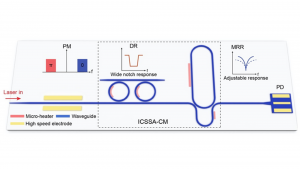A newly-developed chip-sized microwave photonic filter can separate communication signals from noise and suppress unwanted interference across the full radio frequency spectrum.
The photonic filter is expected to be able to help next-generation wireless communication technologies convey data in an environment that is becoming crowded with signals from devices such as cell phones, self-driving vehicles, internet-connected appliances, and smart city infrastructure.
“This new microwave filter chip has the potential to improve wireless communication, such as 6G, leading to faster internet connections, better overall communication experiences, and lower costs and energy consumption for wireless communication systems,” explained Xingjun Wang, a researcher from Peking University.
“These advancements would, directly and indirectly, affect daily life, improving the overall quality of life and enabling new experiences in various domains, such as mobility, smart homes, and public spaces.”
The research, published in Photonics Research, describes how the photonic filter overcomes the limitations of traditional electronic devices to achieve multiple functionalities on a chip-sized device with low power consumption.
“As the electro-optic bandwidth of optoelectronic devices continues to increase unstoppably, we believe that the integrated photonic filter will be one of the important solutions for future 6G wireless communications,” said Wang. “Only a well-designed integrated microwave photonics link can achieve low cost, low power consumption, and superior filtering performance.”
How does the filter improve issues with communications networks?
To improve the currently deployed 5G communication network, 6G technology is currently under development. 6G networks are expected to use millimetre wave and even terahertz frequency bands. Because the use of these will distribute signals over a vast frequency spectrum with an increased data rate, there is a high likelihood of interference between different communication channels.
The researchers hoped that their photonic filter would successfully solve these issues within communication technologies and sought to develop a filter that could protect signal receivers from various types of interference across the full radio frequency spectrum.
The new photonic filter is the first of its kind
In their paper, the researchers explained that to be cost-effective and practical for widespread deployment, it was essential for the photonic filter to be small, consume little power, achieve multiple filtering functions, and be able to be integrated on a chip.

However, previous demonstrations have been limited by their few functions, large size, limited bandwidth, or requirements associated with electrical components. Therefore, the researchers created a more simplified photonic architecture with four main parts.
Firstly, a phase modulator serves as the input of the radio frequency signal, which modulates the electrical signal onto the optical domain. Next, a double-ring acts as a switch to shape the modulation format, with an adjustable micro ring as the core unit for processing the signal. Finally, a photodetector serves as the output of the radio frequency signal and recovers the radio frequency signal from the optical signal.
Wang commented: “The greatest innovation here is breaking the barriers between devices and achieving mutual collaboration between them.
“The collaborative operation of the double-ring and micro ring enables the realisation of the intensity-consistent single-stage-adjustable cascaded-micro ring (ICSSA-CM) architecture. Owing to the high reconfigurability of the proposed ICSSA-CM, no extra radio frequency device is needed to construct various filtering functions, simplifying the whole system composition.”
Demonstrating the device’s innovative performance
To test the photonic filter, the researchers used high-frequency probes to load a radio frequency signal into the chip and collected the recovered signal with a high-speed photodetector.
Additionally, they also used an arbitrary waveform generator and directional antennas to simulate the generation of 2Gb/s high-speed wireless transmission signals and a high-speed oscilloscope to receive the processed signal. By comparing the results with and without the use of the photonic filter, the researchers were able to demonstrate the filter’s performance.

Overall, the results showed that the simplified photonic architecture achieves a comparable performance with lower system complexity compared with previous programmable integrated microwave photonic filters composed of hundreds of repeating units. Therefore, the innovative filter is more robust, energy-efficient, and easier to manufacture than other comparable devices.
Now, the researchers are planning to optimise the modulator further and improve the overall architecture of the photonic filter. These improvements will enable the filter to achieve a higher dynamic range and lower noise, all while ensuring high integration at both the device and system levels.









